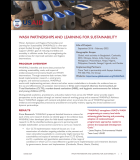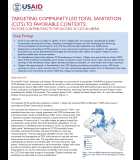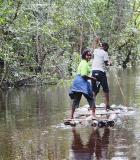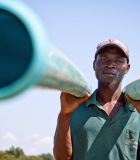Improved Water, Sanitation & Hygiene Program (IWASH)
IWASH facilitates accelerated achievement of the Millennium Development Goals (MDGs) related to water and sanitation, in February 2010. The IWASH program goal is “to make measurable improvements in water supply, sanitation and hygiene (WASH), as well as in the enabling environment for WASH, in target areas within the three counties of Bong, Lofa and Nimba, and selected communities in greater Monrovia” to improve health outcomes for community members.
In 2011, the IWASH program was re-oriented in response to a USAID request narrow the geographic focus of program activities, and devoted a greater level of effort and resources to improving the enabling environment at multiple levels of government. The realignment reflected an overarching focus on tenets of both the USAID/Forward approach and the Global Health Initiative (GHI) strategy, and allowed for greater program focus and impact. Later, in FY2013, IWASH responded to a midterm evaluation by refocusing the activities of the program into 10 projects which streamlined the activities of the program and focused on sustainable sanitation through Community-Led Total Sanitation (CLTS).
Activity Description
A major focus of the IWASH project has been to develop the enabling environment for WASH improvements in Liberia. At the national level, IWASH worked closely with the National Technical Coordinating Unit (NTCU) for CLTS, created county and district level steering committees, and frequently installed Environmental Health Technicians (EHT) into county and district structures where they were not present in order to capacitate local health structures for CLTS implementation.
IWASH mainstreamed sustainable behavior change through behavior change communications (BCC) and community mobilization via community led total sanitation (CLTS)—a participatory methodology that mobilizes communities to completely eliminate open defecation, the IWASH program addressed multiple aspects of personal and communal water and hygiene practices and management.
Water point maintenance was another core component of the IWASH program. The IWASH Entrepreneur Manager held monthly meetings between WASH Entrepreneurs and County WASH Coordinators from the Ministry of Public Works (MPW). These meetings connected the private sector product and service providers with their government counterparts, so that the responsible government agency was aware of private sector activities in the sector. MPW staff also participated in WASH Entrepreneur trainings and graduations.
Expected Outcomes
- Increased access to water supply, sanitation, and hygiene products
- Increased community knowledge and use of potable water supply and storage technologies, sanitary practices, and water hygiene
- Improved enabling environment for WASH at the national, county, district, and community level.
Actual Outcomes
- Access to improved sanitation through CLTS, implemented by the innovative Natural Leader Network driven model, exceeded triggering and Open Defecation Free (ODF) community targets by 25 percent and 41 percent, respectively
- 388 (48 new, 340 rehabilitated) water points constructed or rehabilitated in target communities
- 86 percent of IWASH communities using their own funds (cash box) to operate and maintain their drinking water source





